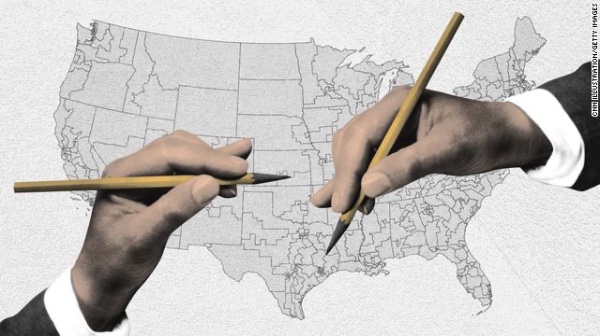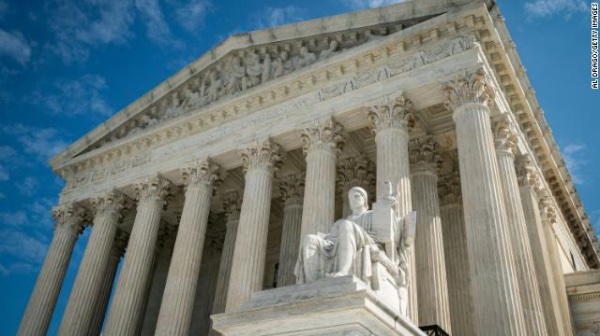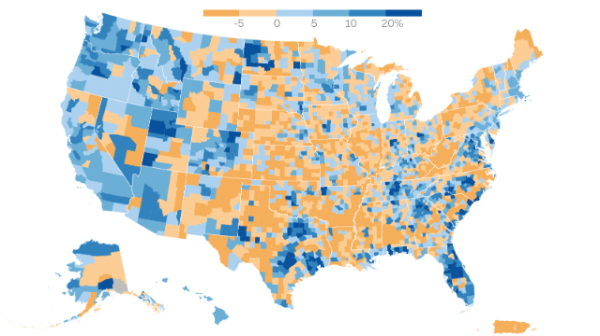View in Browser

March 8, 2022 | by Fredreka Schouten and Kelly Mena
HOW DEMOCRATS ARE WINNING CONGRESSIONAL REDISTRICTING FIGHTS
We’re devoting this newsletter to redistricting – the once-a-decade process of redrawing the lines for congressional districts to reflect population shifts after the US Census.
The main goal, as enshrined in the Constitution, is straightforward: US House seats should be equally apportioned among the states. New maps, then, must be drawn to reflect where the population has grown or shrunk.
The process sounds simple – yet it is anything but that.
And gerrymandering -- the practice of drawing maps to benefit a political party or a group of voters -- has helped make American politics more partisan. Districts have grown more homogenous, dominated by Republican voters or Democratic voters. If a congressional seat is safe from any real competition on Election Day, what incentive remains for a member of Congress to negotiate with the opposing party to actually accomplish something?
We’ve turned to three in-house experts who are following the issue closely -- Ethan Cohen and Melissa Holzberg DePalo, who are producers for CNN’s Political Unit, and CNN Politics’ justice writer Tierney Sneed -- to explain redistricting and to give CITIZEN BY CNN readers the latest developments.
Here's Ethan and Melissa:

Who draws the maps?
When redistricting works like it’s supposed to, congressional district maps are drawn by either state lawmakers or by state redistricting commissions. But like many best-laid plans, that’s not what has happened in every state.
Courts have had to draw or choose the maps in six states, either because the normal processes failed to produce a plan (usually when control of state government is split between the parties) or because the produced maps failed to comply with legal standards.
Where do things stand today with redistricting? Is it over yet?
We’re about eight months from Election Day and the redistricting process still isn’t finished, delayed in part by the pandemic-driven late release of the census data required.
Four states -- Florida, Missouri, New Hampshire and Louisiana -- still have yet to enact their final maps. In all four of those states, congressional maps are passed just like other legislation. Republicans have full control of state government in the first three states, but they haven’t passed maps amid intra-GOP disputes about how aggressively to draw the lines.
In Louisiana, the state legislature recently passed a new map, but Democratic Gov. John Bel Edwards hasn’t announced whether he’ll sign it.
And as litigation over newly drawn maps continues across the country, it’s possible maps in other states will need to be revised as well.
What’s been the biggest surprise about redistricting?
Republicans control most state legislatures across the country, so going into this redistricting process, a lot of analysts believed the GOP would be able to benefit significantly from new maps – especially since the party is trying to regain control of the House in November.
But Democrats have had legal victories in states like Pennsylvania and North Carolina that resulted in more favorable maps. Democrats have also been able to utilize their advantage in states like New York, where they control the redistricting process.
They now have a chance to come out better than expected, and perhaps even benefit from the new maps overall.
However, Democrats still face an uphill climb to hold the House this November as they deal with President Joe Biden’s low approval numbers and the historic trend of poor midterm performance from the party that controls the White House.
Two of the strangest terms to arise about drawing congressional maps are “cracking” and “packing.” What do they mean and how do they work?
In the simplest terms, “cracking” and “packing” are two ways congressional map-drawers gerrymander districts. Cracking is when mapmakers weaken a particular group’s influence by spreading those voters throughout several districts. And packing is when specific voters are forced into one district, or as few districts as possible, to condense their influence.
Tennessee Republicans gave us a good idea of what cracking looks like this year.
For most of Tennessee’s history, Nashville has been in one congressional district. And for most of modern political history, in a sea of deep-red Tennessee, Nashville’s district consistently sent Democrats to Congress. But this year, Republicans in the state divided Davidson County, where Nashville is, into three congressional districts that are paired with more conservative and rural parts of the state. That split, or crack, will weaken the influence of the more liberal Nashville population.
It also should be noted that Republicans aren’t the only ones engaged in partisan map drawing. In states like New Mexico, Illinois and New York, Democrats drew lines to benefit their partisan interests.
Here's Tierney:

Where are the big legal fights happening and what are they about?
With each redistricting cycle, the legal fight over partisan advantage in map-drawing seems to get more complicated. And this cycle is no exception.
In 2019, the US Supreme Court said that federal courts could not play a role in policing partisan gerrymandering. So, some of the most impactful legal fights this cycle are playing out in state courts, where voters have challenged maps for giving one party too much of an advantage.
Federal courts still have the authority to review claims of racial gerrymandering. Depending on the facts on the ground, maps alleged to be racially discriminatory can be challenged under the Voting Rights Act (VRA), under the Constitution or both.
However, the Supreme Court has signaled that it may soon scale back the scope of the VRA in redistricting, which would leave voters, political parties and voter rights organizations with even fewer options to challenge unfair maps in court.
In the lawsuits that are alleging that the political power of minority voters is being diluted, we are seeing a lot of arguments about how communities of color have grown in places like Texas and Georgia, with cases claiming that the new maps do not adequately reflect that growth.
In Texas, for instance, people of color made up 95% of the population growth that led to the state being awarded two additional seats in the US House this decade. Yet both of those districts were drawn to have White voting majorities, as the Justice Department argued in the lawsuit it brought against the state.
Americans already have begun to vote in primaries, so how will these court cases affect actual elections?
It depends on the state. In some states, like Texas and Georgia, the current lawsuits won’t change the maps before this year’s election.
Part of the issue legal challengers have run into is that maps were drawn much later last year than usual. That is because the Covid-19 pandemic delayed the 2020 Census – which produces the data for each decade’s redrawing of maps – which, in turn, delayed the release date for the data from that survey.
In some states, legislators or courts pushed back their electoral calendars because of coronavirus-created time crunch. But we’re still seeing the legal fights over the maps run into election deadlines. In Ohio, for example, local election officials and GOP state leaders are sparring over whether to move the May 3 primary date as the redistricting commission has repeatedly seen its maps rejected by the Ohio Supreme Court.
Another complication – particularly in the federal redistricting litigation – is a recent move by the Supreme Court that has discouraged lower courts from disturbing the maps for this years’ election, even when those courts think the maps violate the law.
Alabama earlier this year had been ordered by two federal courts to redraw its congressional map, after the courts found it likely violated the Voting Rights Act by diluting the political power of Black voters.
But at Alabama’s request, the Supreme Court, by a 5-4 vote, intervened to put that order on hold. The full majority didn’t explain its reasoning, but Justice Brett Kavanaugh, joined by Justice Samuel Alito, wrote a concurrence that touted a legal principle of avoiding court actions that could cause confusion among voters.
Justice Elena Kagan, one of the court’s liberal justices, shot back in a dissent: “Alabama is not entitled to keep violating Black Alabamians’ voting rights just because the court’s order came down in the first month of an election year.”
Already, a district judge in Georgia has cited the Supreme Court’s move in Alabama to explain he would not order Georgia to redraw its state legislative maps for its coming elections, even though the judge believes that they violated the Voting Rights Act.
Where’s the Supreme Court on all of this?
As you may have picked up by now, the Supreme Court -- particularly this current conservative majority – has generally shown more sympathy to legislators who have drawn potentially unfair or discriminatory maps than they have to the voters seeking to challenge those plans.
The Supreme Court’s 2015 Shelby County decision set the stage for this trend. In that case, the conservative majority gutted a provision in the Voting Rights Act that required states with a history of racial discrimination in voting practices to get federal approval for their redistricting plans (and any other changes to their election policies).
Since then, the court majority gave Texas key wins in a redistricting racial discrimination case stemming from the 2010 census cycle. The 2019 partisan redistricting decision, known as Rucho v. Common Cause put an end to any hopes that federal courts could rein in maps aggressively skewed towards one party or another.
Though the court hasn’t weighed in on the merits of the Alabama case, its willingness to jump in at the preliminary stage it was in suggests the court is going to scale back the Voting Rights Act’s reach in redistricting once again, by making it harder for legal challengers to prove that maps can be drawn in way that don’t undermine minority voters.
However, in a setback for Republicans, the Supreme Court on Monday rebuffed efforts to disturb maps adopted by state courts in Pennsylvania and North Carolina.
While the 2022 elections in Pennsylvania and North Carolina will be conducted with redistricting plans less favorable to Republicans, the Supreme Court’s conservative wing has signaled an interest in considering a case down the road that would limit the ability of state courts to rein in partisan gerrymanders.
YOU NEED TO READ

- CNN’s interactive that explores Census data to show how America has grown more diverse and more multiracial than ever before.
- Kaanita Iyer’s story for CNN on fears that redistricting battles in Alabama and other states will lead to voter suppression.
- CNN’s Steve Contorno’s look at GOP Florida Gov. Ron DeSantis’ power plays on redistricting.
- Fredreka’s piece on the erosion of Black political power in the South after the nation’s high court weakened the Voting Rights Act.
ON THE CALENDAR

In less than a month, voters will decide who will finish out ex-Rep. Devin Nunes’ term in California’s 22nd congressional district. Nunes left Congress earlier this year to run former President Donald Trump’s social media company.
The Republican exited office as the contours of his district changed through redistricting. The special election is April 5, with a runoff set for June 7 if no candidate receives more than 50% of the vote next month. Whoever wins the seat likely won't have a district to run in come November.
The full list of candidates and details on how to vote can be found here from the California Secretary of State.
CNN’s Maeve Reston took a deep dive into California’s redistricting process and how it scrambled the playing field for both political parties.
DID YOU MISS LAST WEEK'S CONVERSATION?
Last week, CNN's John King was joined by Brianna Keilar, Abby Phillip and Nia-Malika Henderson to talk about the perilous times the world is in and the importance of quality journalism when democracy is under attack. Click here to watch.
Click here to watch Citizen by CNN events on YouTube.
WHAT WE'RE TYRING TO DO HERE
Our goal is to help guide a running conversation about voting rights in what could be a critical year for American democracy. We’re sharing the latest developments in the battle for ballot access, hearing from experts, answering your questions and providing practical information about how to vote this year. Look for it in your inbox every Tuesday – along with a way to sign up for the free weekly CITIZEN BY CNN events. And, please, drop us a line to let us know what you think: [email protected]. And get your friends to subscribe here.
CITIZEN BY CNN
You are receiving this newsletter because you're subscribed to Citizen by CNN.
No longer want to receive this newsletter? Unsubscribe.
Interested in more? See all of our newsletters.
Create CNN Account | Listen to CNN Audio | Download the CNN App
® © 2022 Cable News Network, Inc.
A WarnerMedia Company. All Rights Reserved.
One CNN Center Atlanta, GA 30303
|
|

